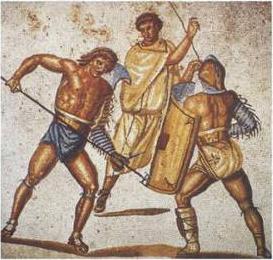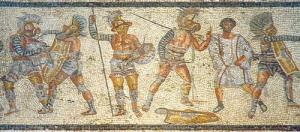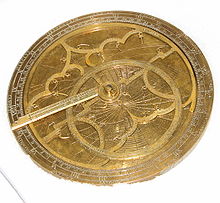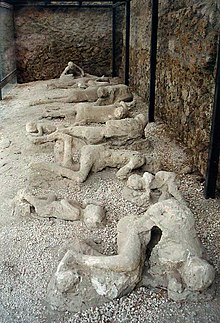
by fljustice | Oct 5, 2015 | Essays/Research, Gladiators, Gladiatrix, History
A Day at the Pompeii Arena
 It’s a sunny day in Pompeii on April 8th in this first year of the reign of Imperator Titus Caesar Vespasianus Augustus (AD 79). The crowds surge toward the amphitheater for the games given by D. Lucretius Stater Valens, a lifelong priest to the cult of the deified Nero Caesar Augustus. The placards pasted on the walls in the forum promise, “ten pairs of gladiators owned by his son D. Lucretius Valens and wild animal hunts, as permitted by law. The seats will be shaded with awnings.” Pompeii’s is the oldest stone amphitheater in the empire. For one hundred-fifty years it has proudly hosted games and religious festivals, but it’s looking dated next to the modern Flavian Amphitheater which will open next year in Rome. The frescoes of gladiatorial combat and beast hunts decorating the walls surrounding the sand are fading, but the patrons come for the blood sports, not the art.
It’s a sunny day in Pompeii on April 8th in this first year of the reign of Imperator Titus Caesar Vespasianus Augustus (AD 79). The crowds surge toward the amphitheater for the games given by D. Lucretius Stater Valens, a lifelong priest to the cult of the deified Nero Caesar Augustus. The placards pasted on the walls in the forum promise, “ten pairs of gladiators owned by his son D. Lucretius Valens and wild animal hunts, as permitted by law. The seats will be shaded with awnings.” Pompeii’s is the oldest stone amphitheater in the empire. For one hundred-fifty years it has proudly hosted games and religious festivals, but it’s looking dated next to the modern Flavian Amphitheater which will open next year in Rome. The frescoes of gladiatorial combat and beast hunts decorating the walls surrounding the sand are fading, but the patrons come for the blood sports, not the art.
The spectators pass into the open spaces surrounding the arena where merchants and food vendors hawk their wares. The scent of fresh bread, roasted meats, and sour wine waft through the crowd to mingle with the odor of sweat and hair pomade. People look at their wooden tickets and enter the appropriate gate to spread throughout the amphitheater: the front rows reserved for the leading citizens; the middle for the lesser knights and merchants; and the top for the poor, slaves, and women. Some resent the class divisions at the arena. At the chariot races in the hippodrome, it’s open seating (except for the emperor, of course!) and women mix with the men. (more…)

by fljustice | Apr 8, 2011 | History in the News
History in the News:
Libya’s Treasures, Pickled Bog Brain, and Agatha Christie

Arch of Roman Emperor Lucius Septimius Severus at UNESCO World Heritage Site: Leptis Magna, Libya
The United Nations Educational, Scientific and Cultural Organization (UNESCO) is calling on all sides in the Libya conflict to protect North Africa’s wealth of ancient treasures. Five Libyan sites are on UNESCO’s World Heritage List, including the Roman ruins of Leptis Magna and the ancient Phoenician trading post of Sabratha, close to the capital Tripoli. In the rebel-held eastern section, the ancient mountain city of Cyrene is vulnerable. (Map of threatened areas. Link to original story.)
Under the Qaddafi regime, the ancient Roman and Greek cities dotting the Mediterranean coast have suffered from neglect. Qaddafi preferred to develop the oil of his country (Libya has about 2% of the world’s reserves) and little money was spent on developing the tourist industry or protecting important archaeological sites. Sheep are penned in the Greek theater at Cyrene and goats roam the ruins. Locals are hoping that tourism will bring some prosperity to their area when hostilities cease. (Link to original story.) (more…)

by Faith Justice | Aug 18, 2010 | History, History in the News
History in the News:
Pyroclastic Clouds, Dead Dogs, and Ads on the Coliseum
As I’ve said on my About page, I’m a history junkie and science geek. I love the intersection of these two disciplines: DNA markers that trace humankind’s exodus from Africa, isotope analysis of teeth and bones that tell us where and when ancient people grew up and what they ate, UV light to fluoresce bones and fingerprints on artifacts, and much more. Over half of my “history in the news” stories this round up have a major science component–from what really killed people in Pompeii to discovering a “lost” Roman city from aerial photographs to where the Dead Sea Scrolls were manufactured. You can click on the links to see the original stories. We’ll start with Pompeii.
 Most historians and archaeologists believed the people at Pompeii, who where not killed by spewing rocks, died of suffocation from ash and poisonous gas. Pliny the Younger described the process in letters written 25 years later. Giuseppe Mastrolorenzo, a vulcanologist from the Naples Observatory claims “Everything that has been written in the guides, and the texts, and that has been re-told to tourists [about how people died at Pompeii] is false.” He spent years analyzing skeletal casts, testing bone tissue and simulating Vesuvius eruptions. He published his findings in the science journal PLoS One. Mastrolorenzo concludes that the people of Pompeii were instantly killed by a pyroclastic cloud, a surge of super-heated air. He also proved these high temperatures can be carried up to 12 miles away from the volcano. The Italian Civil Protection requires only those people living five miles from Vesuvius to evacuate, which puts 3 million people in and around Naples in harm’s way, in case of another eruption.
Most historians and archaeologists believed the people at Pompeii, who where not killed by spewing rocks, died of suffocation from ash and poisonous gas. Pliny the Younger described the process in letters written 25 years later. Giuseppe Mastrolorenzo, a vulcanologist from the Naples Observatory claims “Everything that has been written in the guides, and the texts, and that has been re-told to tourists [about how people died at Pompeii] is false.” He spent years analyzing skeletal casts, testing bone tissue and simulating Vesuvius eruptions. He published his findings in the science journal PLoS One. Mastrolorenzo concludes that the people of Pompeii were instantly killed by a pyroclastic cloud, a surge of super-heated air. He also proved these high temperatures can be carried up to 12 miles away from the volcano. The Italian Civil Protection requires only those people living five miles from Vesuvius to evacuate, which puts 3 million people in and around Naples in harm’s way, in case of another eruption.
(more…)

 It’s a sunny day in Pompeii on April 8th in this first year of the reign of Imperator Titus Caesar Vespasianus Augustus (AD 79). The crowds surge toward the amphitheater for the games given by D. Lucretius Stater Valens, a lifelong priest to the cult of the deified Nero Caesar Augustus. The placards pasted on the walls in the forum promise, “ten pairs of gladiators owned by his son D. Lucretius Valens and wild animal hunts, as permitted by law. The seats will be shaded with awnings.” Pompeii’s is the oldest stone amphitheater in the empire. For one hundred-fifty years it has proudly hosted games and religious festivals, but it’s looking dated next to the modern Flavian Amphitheater which will open next year in Rome. The frescoes of gladiatorial combat and beast hunts decorating the walls surrounding the sand are fading, but the patrons come for the blood sports, not the art.
It’s a sunny day in Pompeii on April 8th in this first year of the reign of Imperator Titus Caesar Vespasianus Augustus (AD 79). The crowds surge toward the amphitheater for the games given by D. Lucretius Stater Valens, a lifelong priest to the cult of the deified Nero Caesar Augustus. The placards pasted on the walls in the forum promise, “ten pairs of gladiators owned by his son D. Lucretius Valens and wild animal hunts, as permitted by law. The seats will be shaded with awnings.” Pompeii’s is the oldest stone amphitheater in the empire. For one hundred-fifty years it has proudly hosted games and religious festivals, but it’s looking dated next to the modern Flavian Amphitheater which will open next year in Rome. The frescoes of gladiatorial combat and beast hunts decorating the walls surrounding the sand are fading, but the patrons come for the blood sports, not the art.

